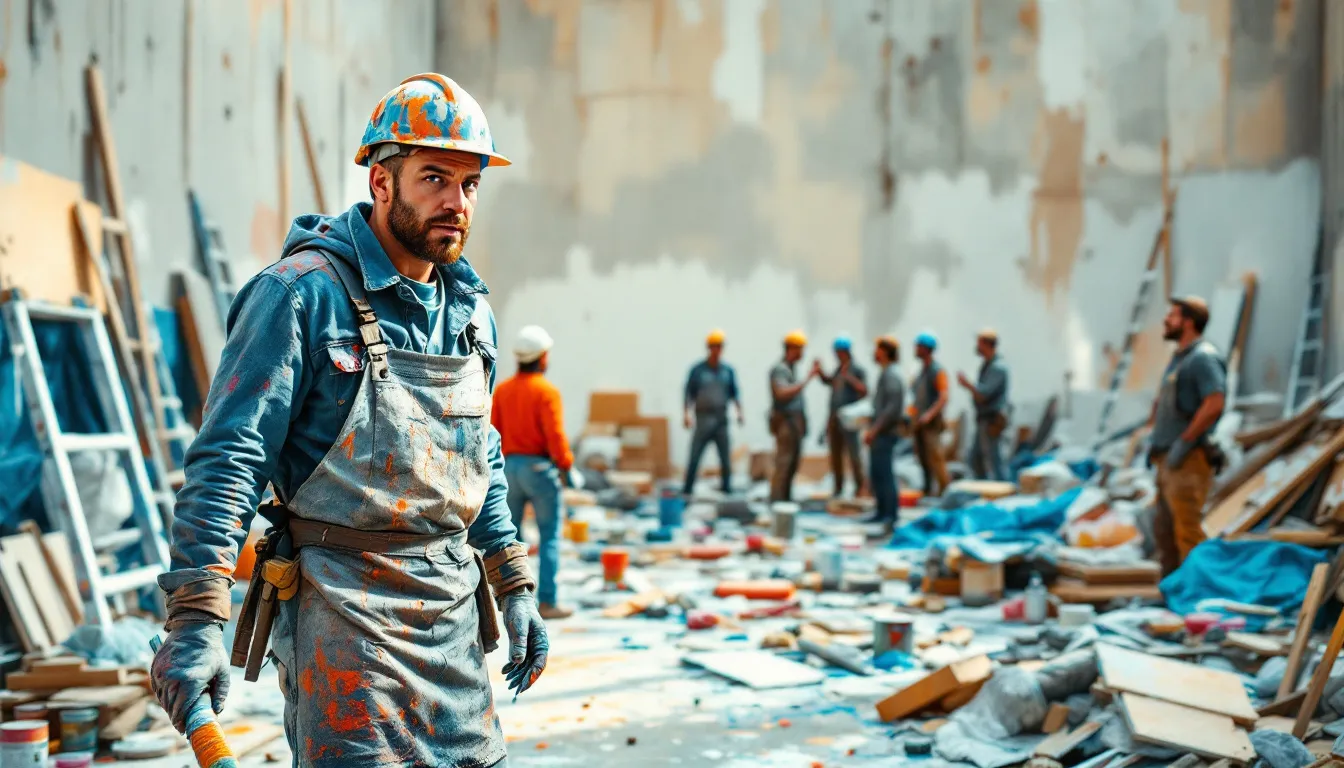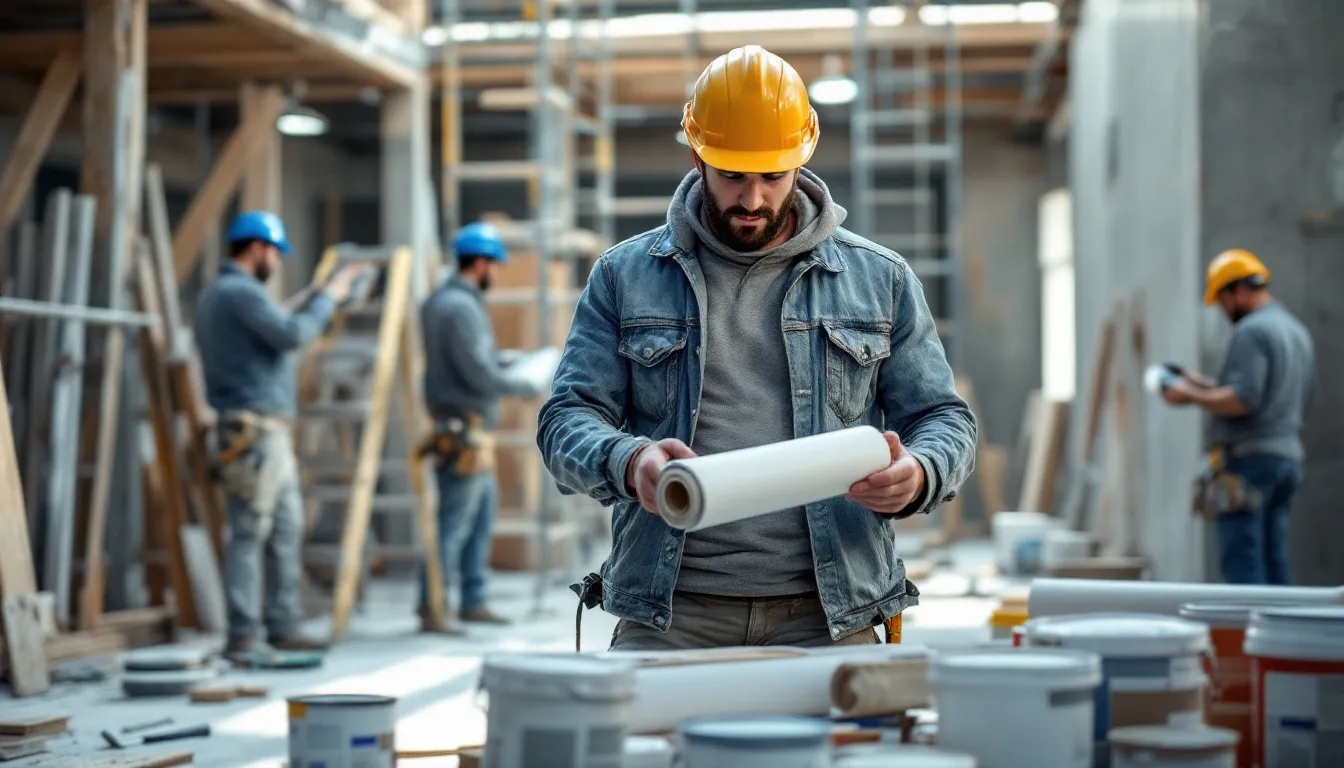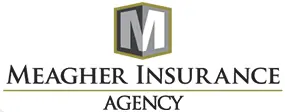What are the hidden costs of painting without coverage? You might save some money initially, but the risks of damages, legal troubles, delays, and increased labor costs can quickly add up. In this article, we share real job site stories to reveal the hidden costs of painting without coverage: stories from the job site, highlighting the true costs of skipping coverage.
Key Takeaways
- Skipping insurance coverage on painting jobs can lead to significant financial losses, legal disputes, and increased project delays.
- Inadequate surface preparation and insufficient paint coverage result in higher labor costs and potential damage, necessitating costly corrections.
- Investing in high-quality materials and following best practices can reduce overall expenses and improve the durability and aesthetic quality of paint jobs.
The True Cost of Skipping Coverage

Skipping coverage on a painting job can have severe financial implications. Without adequate insurance, unexpected damages during the project can lead to significant financial losses for both homeowners and painters. Numerous real-life examples show how uninsured incidents result in costly repairs that could have been mitigated with proper coverage, often costing far more than the initial savings from skipping insurance.
Additionally, lack of coverage can cause delays and extra costs. Painters might have to halt work to resolve unforeseen issues, leading to costly delays in project completion. These interruptions increase the total project cost and frustrate clients who expect timely completion.
Legal challenges also present hidden costs. Painters without insurance may face claims for job-site accidents, leading to potential lawsuits and significant legal fees. These legal disputes can financially cripple small painting businesses, underscoring the need for proper coverage.
Damage to Surfaces
Neglecting proper coverage almost inevitably leads to surface damage. Insufficient paint coverage often results in peeling and bubbling, especially in moisture-prone areas like kitchens and bathrooms. This not only ruins the aesthetic appeal but also requires additional coats of paint, increasing both material and labor costs.
In some cases, old paint becomes visible under new coats if not enough layers are applied, indicating inadequate coverage and poor preparation. This is especially problematic in high-traffic areas where durability is essential. Reapplying paint in these areas adds to the overall cost and time required for the project.
Proper surface preparation accounts for about 85% of an average successful paint job. Tasks such as filling holes and sanding surfaces are crucial. Skipping these steps can result in uneven paint application and require additional labor to fix issues like peeling or uneven paint.
Harsh environmental conditions can further accelerate paint degradation, leading to more frequent repair and higher long-term costs.
Increased Labor Costs
Skipping coverage can significantly increase labor costs. Proper surface preparation is crucial for a successful paint job. Skipping crucial steps like cleaning and repairing damages before painting can result in poor adhesion and further damage, requiring additional labor time to correct. This extra time directly translates into higher costs for both homeowners and painters.
Using painter’s tape to prevent paint bleed and protect existing surfaces is another critical step often overlooked. Neglecting it leads to substantial prep work, increasing labor time and associated costs. Inconsistent paint application due to improper coverage can cause uneven textures and colors, often necessitating costly repairs and rework.
Neglecting to apply a primer can result in uneven paint coverage, contributing to the deterioration of painted surfaces over time. This means more labor hours spent on cleaning and preparation after painting, which all add up to increased labor costs. Additionally, inadequate paint application often requires multiple coats, leading to increased paint consumption and higher costs.
Paint Waste and Overuse

Poor coverage leads to significant paint waste and overuse. When areas are left unpainted due to inadequate coverage, additional paint purchases become necessary, contributing to waste. This not only increases overall paint costs but also leads to environmental waste due to excess material that ultimately gets discarded.
Estimating the right amount of paint needed is crucial to avoid interruptions and additional costs. Typically, one gallon covers around 400 square foot. However, how many gallons of paint may be required if inadequate preparation or application techniques cause the paint to be absorbed by surfaces, requiring more product than initially estimated for the square footage of gallons.
Using high quality paint can reduce the need for two coats, leading to less overall paint usage and lower long-term costs, allowing you to save money. If you want to buy paint, consider the benefits of high quality options.
Health and Safety Risks
Health and safety risks are another hidden cost of insufficient coverage. Indoor paints can emit volatile organic compounds (VOCs), posing health risks when inhaled. Short-term exposure to paint fumes can lead to symptoms like headaches, dizziness, and lung irritation in the interior environment. For individuals with pre-existing respiratory conditions, the risks are even greater.
Pregnant women and small children should avoid exposure to paint fumes due to potential health implications.
Client Dissatisfaction
Skipping coverage can lead to significant client dissatisfaction. Property owners can potentially be held liable for damages caused by independent contractors depending on the circumstances and applicable state laws. This liability can arise if an owner negligently supervises or instructs a painting contractor, leading to property damage. In some jurisdictions, the inherently dangerous nature of certain painting tasks may hold the property owner responsible for damages caused by contractors.
Such situations can lead to disputes and dissatisfaction among clients, damaging the reputation of the painting business. Proper coverage and adherence to safety protocols can help mitigate these risks and maintain a positive relationship with clients.
Financial Impact on Professional Painters

Poor coverage can have a substantial financial impact on professional painters. Homeowners often face higher out-of-pocket expenses if they skip coverage, as they need to cover repairs or replacements without financial support. This financial burden can extend to professional painters, who may need to absorb some of these costs to maintain client relationships.
Accurate estimate of paint needs is crucial for both homeowners and professional painters. Poor coverage can lead to unforeseen expenses due to material waste and increased labor costs. Investing in premium paint may incur higher initial painting costs but can result in significant savings over time due to its durability and reduced maintenance requirements.
Legal Implications
Without proper insurance, painters may face liability for damages caused to clients’ house property, leading to potential legal disputes. Real-life anecdotal evidence shows that projects lacking adequate insurance frequently result in disputes over responsibility for damages.
Such legal challenges can be financially crippling and emphasize the importance of having proper brand coverage to protect both the painter and the client to hire to pay the price for any potential damages, as well as to log any incidents that may arise regarding the location.
Best Practices for Proper Coverage

Ensuring proper coverage involves adhering to best practices. Proper preparation is essential for a quality paint application and can add hours to the project. Tasks such as filling holes, sanding surfaces, and applying primer create a suitable surface for paint, enhancing color vibrancy and adhesion. Waiting the recommended drying time before applying a second coat is crucial to avoid issues like peeling and brush strokes.
When painting, start with the ceiling, then proceed to trim, windows, and finally walls to prevent accidental smudges. Using a roller with the appropriate nap thickness for the surface texture being painted ensures smooth coverage. Ventilating the area by keeping windows open while interior painting can help minimize health risks during your interior painting project.
Investing in Quality Materials

Investing in high-quality materials is crucial for a successful paint job. Using inferior quality paint may require more product to achieve similar coverage compared to higher quality options, increasing overall expenditure. High-quality binders in paints enhance adhesion and provide better resistance to issues like cracking and peeling. Superior pigments contribute to better color retention and a more appealing finish.
Top-tier paints incorporate additives that improve performance, such as preventing mildew and ensuring an even application. Investing in quality materials prevents common issues and ensures a better finish, ultimately saving money and reducing the need for frequent repainting.
Expert Tips from Industry Professionals
Industry experts offer valuable advice on painting techniques and best practices. Choosing the correct type of paintbrush is crucial, as different paints require specific brush materials for optimal results. Weather conditions, particularly humidity, can impact drying times and should be considered before starting an exterior painting job. To prevent dripping, only dip a third of the brush into the paint can when loading it.
Advice from industry experts can guide you in making informed decisions during painting projects. Their insights help achieve a professional painter finish and avoid common pitfalls, ensuring a successful outcome when you hire professional painters and influence your choices.
Summary
In summary, the hidden costs of painting without proper coverage can be significant, affecting both financial and operational aspects of a project. From increased labor costs and paint waste to legal implications and client dissatisfaction, the risks are numerous. By following best practices and investing in high-quality materials, you can avoid these pitfalls and ensure a successful painting project. Remember, proper preparation and coverage are key to achieving a professional finish and long-lasting results.
Frequently Asked Questions
What are the financial implications of skipping coverage on a painting job?
Skipping coverage on a painting job can result in considerable financial losses, including unexpected damages and increased labor costs, as well as potential legal disputes. It is prudent to maintain appropriate coverage to safeguard against these risks.
How can poor coverage damage surfaces?
Poor coverage can result in peeling, bubbling, and the exposure of underlying surfaces, particularly in areas with high traffic or moisture. It is essential to ensure adequate coverage to maintain the integrity and appearance of the surfaces.
Why is proper surface preparation important?
Proper surface preparation is crucial as it enhances paint adhesion and provides a smoother finish, ultimately reducing the likelihood of issues such as peeling or uneven surfaces. Ensuring a well-prepared surface minimizes future labor costs associated with repairs.
How does skipping coverage impact professional painters?
Skipping coverage negatively impacts professional painters by causing increased material waste and higher labor costs, ultimately leading to financial losses.
What are the legal risks of not having proper insurance coverage?
Not having proper insurance coverage exposes individuals to legal risks such as liability for damages resulting in costly legal disputes and financial burdens. It is crucial to maintain adequate insurance to protect against these potential consequences.
